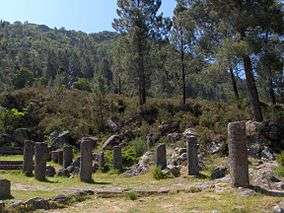Baixa Limia – Serra do Xurés
| Baixa Limia - Serra do Xurés | |
|---|---|
 | |
 Location within Galicia | |
| Location | Galicia, Spain |
| Nearest city | Lobios |
| Coordinates | 41°52′41″N 8°05′42″W / 41.878°N 8.095°W[1]Coordinates: 41°52′41″N 8°05′42″W / 41.878°N 8.095°W[2] |
| Area | 209 km2 (81 sq mi) |
| Established | 1993 |
Baixa Limia – Serra do Xurés is a 209 km2 (81 sq mi) natural park in Galicia, Spain. It is located in the southern province of Ourense. The park was established in 1993. Serra do Xurés is the Galician name for a range of mountains which straddle the border between Spain and Portugal: the Portuguese variant is Gerês and the Castilian variant is Xures (without the accent).
The main geological material of this park is granite. Within the borders of the park are lower elevation glacier cirques.
International recognition
There is also a protected area on the Portuguese side of the border, the Peneda-Gerês National Park. In 2009 a transboundary biosphere reserve was designated by UNESCO which is intended to help the two countries integrate conservation measures. The Council decided to add 22 new sites to the World Network of Biosphere Reserves of UNESCO, which now has a total of 533 reserves spread over 106 countries. One that was added was the International Park Xures-Geres according to UNESCO's website.[3] The importance of the site from an ecological point of view is due to the wealth of forest ecosystems and bogs and a high level of endemic species that has been developed by climatic influences from the Atlantic Ocean and the Mediterranean. Local communities are an integral part of the regional landscape. They have established centers for sustainable development in the reserve to support municipalities in their efforts to strengthen the environmental sustainability criteria in local development.
Baixa Limia – Serra do Xurés is also the name of a Natura 2000 site.[4]
Flora
The park's flora is characterized by a deciduous forest with Pyrenean oak (Quercus pyrenaica), birch (Betula Celtiberian) and Mediterranean elements such as the arbutus and higher altitude holly. There are several endemic plants, including Portuguese laurel, Loron (Prunus lusitanica), a species that colonizes the ravines and other areas that have high humidity.
References
- ↑ Baixa Limia Serra Do Xurés Nature Park protectedplanet.net
- ↑ Baixa Limia Serra Do Xurés Nature Park protectedplanet.net
- ↑ "22 New Sites Join the UNESCO's World Network of Biosphere Reserves". UNESCO. Retrieved 2 May 2012.
- ↑ Site ES0000376, European Environment Agency